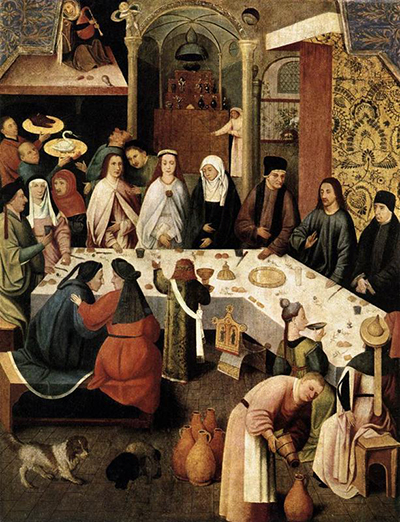Marriage Feast at Cana is a charming oil painting that captures local Netherlandish life and was for a long time attributed to Hieronymus Bosch
The Museum Boijmans Van Beuningen in Rotterdam hold this original artwork alongside several other artworks that remain more confidently attributed to Hieronymus Bosch. It has now been marked as "After Hieronymus Bosch" which is a term used to signify that his may well have come from members of his studio.
There is further uncertainty over this whole topic when you discover that there are three copies of the same theme, one even owned by the same museum where this painting remains. As well as the Museum Boijmans Van Beuningen, Rotterdam there are also two other versions at the Abdij O.-L.-Vrouwe, Tongerlo, Belgium and the Louvre in Paris. The used different angles from which to depict the same scene, and all four are now attributed as "After Hieronymus Bosch".
A course of Dendrochronological analysis was carried out on several Hieronymus Bosch artworks and in many cases it proved beyond doubt that he was that original creator. The same cannot be said for this piece, though, and a date of no earlier than 1550 started to raise significant doubts about what was believed to have been the original from where the other copies followed.
The marriage at Cana is from John 2:1-12 and involves a group sitting around Christ who blesses all those around him. Shortly afterwards he would perform his miracle of turning water into wine as the festivities continued. This fresco had initially been painted over before restorative work removed the layer on top, though it had still caused significant damage on what lied beneath.
Pieter Bruegel the Elder was the most famous artist from this region for capturing the lives of ordinary folk, and would often make use of local gatherings such as weddings. In terms of content, if not style, you can see clear similaties between The Marriage Feast at Cana and Bruegel's paintings such as Peasant Wedding, Peasant Dance and Wedding Dance.
Bruegel's most famous painting was, of course, Hunters in the Snow, but this had quite a different scene to that of our wedding here. That was one of his extensive landscapes, where individual figures would be spread right across a large expanse of European countryside.




